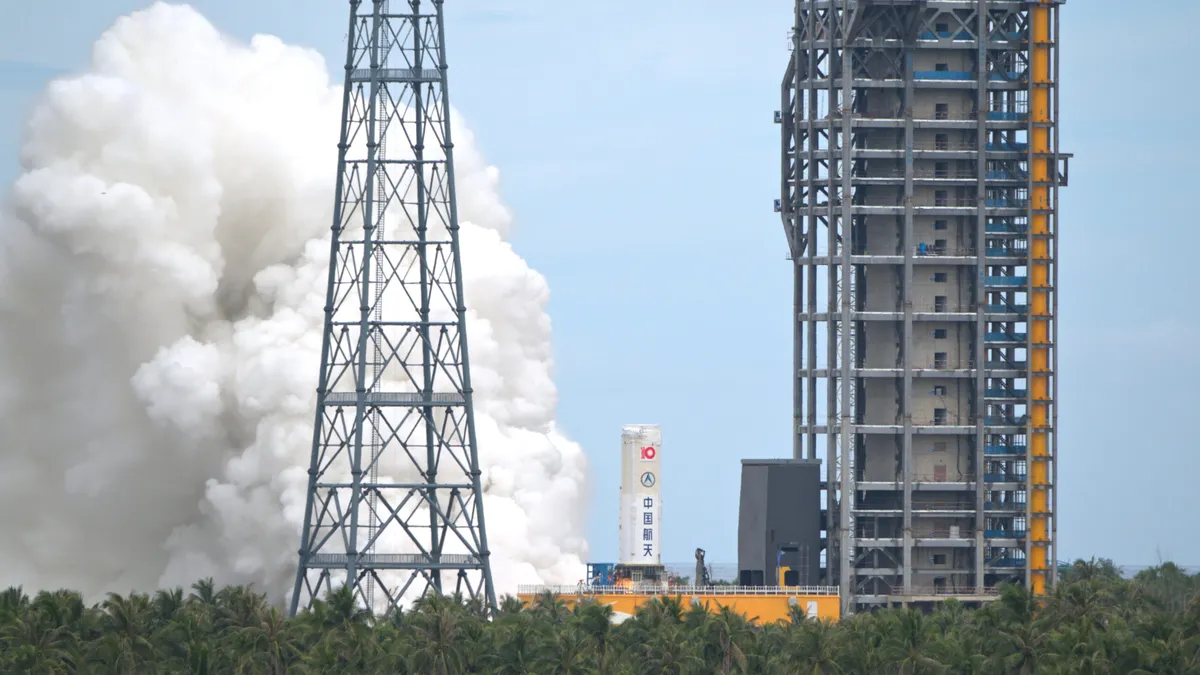
In recent weeks, the Chinese space program has achieved remarkable milestones, positioning itself to land astronauts on the lunar surface by 2030. On August 6, the China Manned Space Agency successfully conducted a test of its high-fidelity mockup of the 26-ton Lanyue lunar lander. This significant test, carried out outside Beijing, utilized giant tethers to simulate lunar gravity while the lander fired its main engines and fine control thrusters to mimic a landing and takeoff from a cratered lunar surface. According to an official statement from the agency, this test marks a crucial step in the development of China's manned lunar exploration program, representing the first successful test of extraterrestrial landing and takeoff capabilities for a manned spacecraft.
The China Manned Space Agency reiterated its commitment to landing astronauts on the Moon before 2030. This announcement was bolstered by another significant achievement on the following Friday, when the agency, in collaboration with the China Academy of Launch Vehicle Technology, conducted a successful 30-second test firing of the Long March 10 rocket. This rocket's center core is powered by seven YF-100K engines, which burn kerosene and liquid oxygen. The primary variant of this rocket is designed to lift approximately 70 metric tons to low-Earth orbit, marking another step forward in China's lunar ambitions.
The successful test of the Long March 10 follows earlier advancements, including a launch escape system test of the new Mengzhou spacecraft in June, which is also intended for lunar missions. Collectively, these efforts indicate that China's space program is making significant progress across all major components of its lunar endeavors: a powerful rocket to launch a crew spacecraft, a lunar lander to transport astronauts to the Moon's surface, and a plan for their return.
While the achievements of China's space program are noteworthy, some in the United States may downplay the significance of these developments. Notably, NASA successfully landed humans on the Moon nearly six decades ago as part of the Apollo Program, leading some to believe that the U.S. has already demonstrated its capabilities in this arena. Furthermore, initial phases of the Chinese program appear to draw inspiration from Apollo, particularly with a lander resembling the iconic Lunar Module.
In response, NASA's Artemis Program aims to build upon the lessons learned from Apollo, focusing on sustainable lunar exploration and the development of in-space propellant storage and refueling technologies. This approach is designed to facilitate lower-cost, reusable lunar missions and establish a robust lunar economy that can support government and commercial enterprises. However, recent setbacks with SpaceX's Starship, one of NASA's lunar landers, suggest that it may still be several years before these newer technologies are fully operational.
As events unfold, it appears increasingly likely that China will achieve a lunar landing before NASA returns astronauts to the Moon. To gain deeper insights into the implications of this potential outcome, Ars Technica spoke with Dean Cheng, a respected analyst specializing in Chinese space policy and the geopolitical ramifications of the ongoing space race.
According to Cheng, the successful demonstration of the Lanyue lander is vital as it reflects China's methodical approach to major scientific projects. By learning from existing data—much of which is publicly available from NASA—China is steadily building its capabilities. Cheng emphasizes that the recent static test of the LM-10 lunar satellite launch vehicle further underscores the momentum of the Chinese lunar program, especially after recent challenges faced by other variants.
Should China successfully land on the Moon before the U.S., the geopolitical consequences would be substantial. Cheng argues that this would signify a shift in global perceptions of American exceptionalism, as the U.S. has historically been the only nation to have successfully carried out lunar landings. The optics of a successful Chinese lunar mission could diminish the long-standing narrative that the U.S. is the leading force in space exploration.
Moreover, if China establishes a long-term presence on the Moon—especially with plans to land near the lunar south pole—it could position itself to dominate technical standards and data protocols for lunar operations. The Chinese government has already indicated intentions to deploy a lunar positioning, navigation, and timing (PNT) network and a communications system, leveraging their existing BeiDou technology.
Looking ahead, the question arises: which nation is better positioned to dominate cislunar space by the middle of the century? While the U.S. boasts a larger economy, extensive space experience, and established industrial capacity for reusable launches, Cheng points out that the U.S. has struggled with programmatic stability. For instance, the Trump administration's shifting priorities regarding lunar and Mars missions have created uncertainty in the U.S. space agenda.
In contrast, China has demonstrated consistent commitment to its long-term goals, with a structured approach to human spaceflight and the development of infrastructure to support future lunar endeavors. Cheng predicts that China will successfully land astronauts on the Moon by 2030 and continue to expand its presence with both crewed and uncrewed missions.
For the U.S. to effectively compete with China, Cheng advises that the administration needs to establish a clear, programmatic commitment to its space goals—whether focused on the Moon or Mars. Mobilizing Congressional and public support for these objectives, along with consistent funding and high-level oversight, is crucial. By fostering an environment conducive to innovation and collaboration with the private sector, the U.S. can enhance its position in the evolving landscape of space exploration.
In conclusion, as China's lunar ambitions unfold, the implications for global space dynamics are profound. The potential for a successful Chinese lunar landing before the U.S. could reshape perceptions of technological leadership and influence in cislunar space for decades to come.